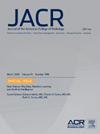Preference Signaling in the Radiology Residency Match: National Survey of Applicants
IF 4
3区 医学
Q1 RADIOLOGY, NUCLEAR MEDICINE & MEDICAL IMAGING
引用次数: 0
Abstract
Objective
Two-tiered preference signaling has been implemented in the radiology residency application system to reduce congestion in the setting of high-volume applications. Signals are an indicator of strong interest that an applicant can transmit to a limited number of programs. This study assessed the impact of program signaling on interview invitations, how applicants strategically used signals based on their application’s competitiveness, and applicants’ attitudes toward the current signaling system.
Methods
A survey was sent to radiology residency applicants registered with TheRadRoom during the 2024 application cycle. We queried the applicants’ background, applications, signal distribution, and interview outcome depending on the type of signal sent. We also asked whether respondents received an interview invitation from a hypothetical “comparator nonsignaled program” if they had one additional signal to use. Group differences were assessed using nonparametric Wilcoxon signed rank test.
Results
A total of 202 applicants completed the survey (28% response rate). Most applied to diagnostic radiology (81%). Nearly all respondents used all six gold (98%) and six silver (96.5%) signals. Interview invitation rates were significantly higher for signaled programs (59.8% ± 27.4%) than nonsignaled (8.5% ± 8.5%); the invitation rate at the comparator nonsignaled programs was 37%. Gold-signaled programs had significantly higher interview rates (67.8% ± 29.3) than silver (51.8% ± 31.3%). Respondents used 49.2% (±21.7%) of their signals for “likely to match” programs, 33.1% (±20.9%) for “aspirational” programs, and 17.6% (±15.8%) for “safety” programs. Most respondents (146; 76%) supported continuing the signaling system for future cycles.
Conclusion
Signaling programs significantly enhanced interview invitation rates, with gold signals being more effective than silver. The applicants used about six total signals for “likely-to-match” programs, two for “aspirational” programs, and about four for “safety” programs.
放射科住院医师配对中的偏好信号:全国申请人调查。
目的:放射科住院医师申请系统采用了两级偏好信号,以减少大量申请时的拥堵情况。信号是一种表示强烈兴趣的指标,申请人可将其传递给数量有限的项目。本研究评估了项目信号对面试邀请的影响、申请人如何根据其申请的竞争力战略性地使用信号,以及申请人对当前信号系统的态度:我们向2024年申请周期内在TheRadRoom注册的放射学住院医师申请者发送了一份调查问卷。我们根据发送信号的类型询问了申请人的背景、申请情况、信号分布和面试结果。我们还询问了受访者,如果他们有一个额外的信号可使用,他们是否收到了一个假定的 "无信号参照程序 "的面试邀请。组间差异采用非参数 Wilcoxon 符号秩检验进行评估:共有 202 名申请人完成了调查(回复率为 28%)。大多数申请者从事放射诊断工作(81%)。几乎所有受访者都使用了全部 6 种金信号(98%)和 6 种银信号(96.5%)。金牌项目的面试邀请率(59.8%±27.4%)明显高于非金牌项目(8.5%±8.5%);非金牌项目的面试邀请率为 37%。金牌项目的面试率(67.8%±29.3)明显高于银牌项目(51.8%±31.3%)。受访者将 49.2%(±21.7%)的信号用于 "可能匹配 "的项目,33.1%(±20.9%)用于 "有抱负 "的项目,17.6%(±15.8%)用于 "安全 "的项目。大多数受访者(146;76%)支持在今后的周期中继续采用信号系统:信号系统大大提高了面试邀请率,金信号比银信号更有效。申请人在 "可能匹配 "项目中总共使用了约 6 个信号,在 "有抱负 "项目中使用了 2 个信号,在 "安全 "项目中使用了约 4 个信号。
本文章由计算机程序翻译,如有差异,请以英文原文为准。
求助全文
约1分钟内获得全文
求助全文
来源期刊

Journal of the American College of Radiology
RADIOLOGY, NUCLEAR MEDICINE & MEDICAL IMAGING-
CiteScore
6.30
自引率
8.90%
发文量
312
审稿时长
34 days
期刊介绍:
The official journal of the American College of Radiology, JACR informs its readers of timely, pertinent, and important topics affecting the practice of diagnostic radiologists, interventional radiologists, medical physicists, and radiation oncologists. In so doing, JACR improves their practices and helps optimize their role in the health care system. By providing a forum for informative, well-written articles on health policy, clinical practice, practice management, data science, and education, JACR engages readers in a dialogue that ultimately benefits patient care.
 求助内容:
求助内容: 应助结果提醒方式:
应助结果提醒方式:


